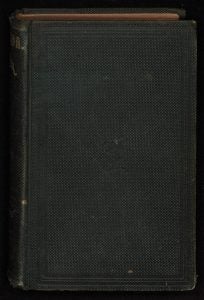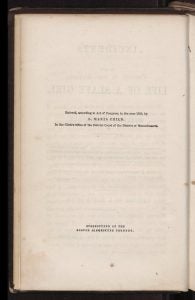Conservation Corner: Incidents in the Life of a Slave Girl


When the two first edition copies of Incidents in the Life of a Slave Girl in Joyner Library’s holdings came across my work bench a few months ago, the similarity between the two volumes was striking. While the cloth on the covers are different colors, one a dark green and the other brown, the two volumes are otherwise completely identical from the stamped cover design to the printed text inside. The identical nature of these books intrigued the bibliophile in me, so I had to look further.
As the rear of the title page proudly proclaims, these books were printed using a process called stereotyping.

So, what is stereotyping and why do we care? Prior to the 19th century moveable type was the best option for publishing printed text. This involved hand setting every letter and space, paragraph by paragraph, page by page. Once the print run was finished, the type had to be broken back down into type cases since storing set type was both expensive and impractical. With literacy and therefore the demand for literature on the rise, the 1800’s saw many instances where a book was popular enough to warrant multiple print runs. Due to the constrains of this print process the setting and breaking down of type would have to be performed multiple times. The Stereotyping process uses papier-maché or plaster poured over a galley of set type to make a mould. These moulds, also known as ‘flongs’, are used to cast a solid metal printing plates. The resulting plates were more compact, easier to move, and store. Multiple plates could be produced with almost no variation from plate to plate and did not require the time involved in resetting type for every printed edition.
The term ‘stereotype’ comes from the Greek words stereós, meaning fixed or stable, and týpos, meaning impression. Though there is scholarly disagreement over who invented the new printing process, but there is no denying that once it was introduced to the United States it was responsible for the production of a large majority of popular fiction in the mid-19th century. A mere decade before the publishing of Incidents in the Life of a Slave Girl, Harriet Beecher Stowe’s revolutionary slave narrative (and the subject of last month’s blog post), Uncle Tom’s Cabin was published utilizing the same printing process. Originally serialized in the abolitionist paper “the National Era,” throughout its year long run, Beecher-Stowe’s publisher John P. Jewett was having the text stereotyped. Considering the initial high costs associated with producing stereotyping plates, it is clear Jewett anticipated the text to be hugely popular.
There was great personal risk in Jacobs telling her story as an escaped slave, publishing her memoirs under her own name would have endangered her and her associates under the Fugitive Slave Act. Jacob’s publisher Lydia Maria Child recognized the dangers as well as the importance of the first-person narrative to bolster support for the abolition movement. As a result, Jacobs’ memoir was first published under the pseudonym Lynda Brent. With writers like Beecher-Stowe paving the way and new print technology allowing for widespread distribution, the impact Harriet Jacobs’ writing is still felt today.
Written by: Linnea Vegh, Conservation Technician
Sources:
Salade, Robert Francis. Handbook of Electrotyping and Stereotyping. Oswald Pub. Co., 1923.